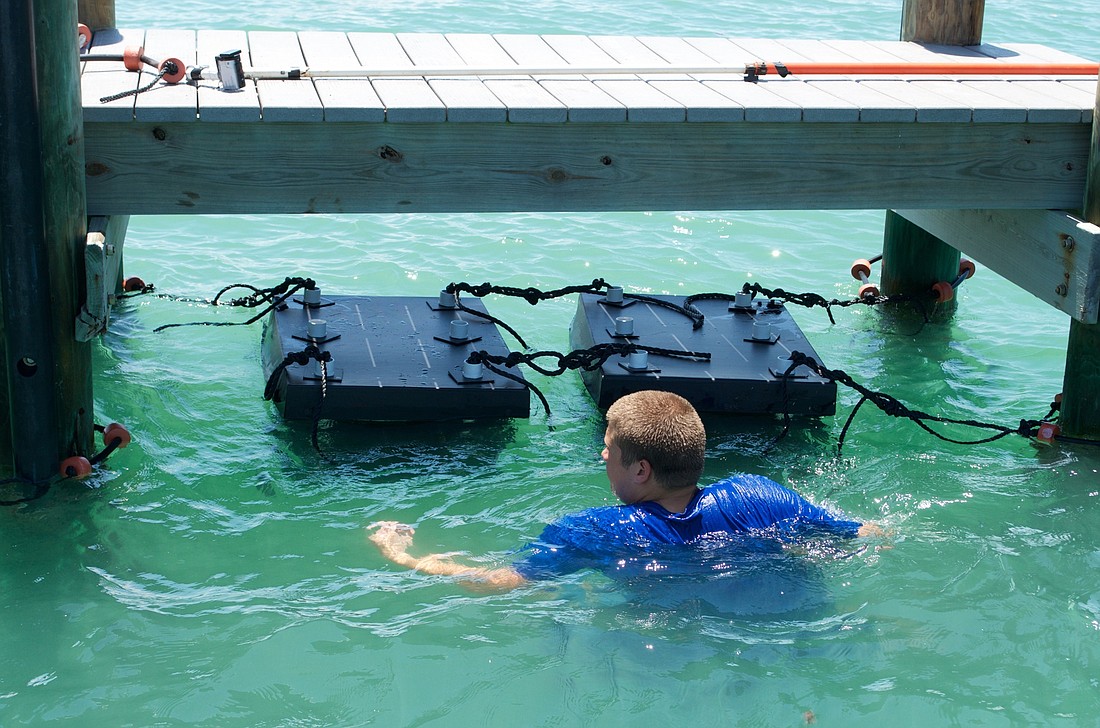- April 25, 2024
-
-
Loading

Loading

Not long after the Siesta Key Association installed 34 new mini-reefs to restore canal waterways, water samples and scientific data were gathered for the first time in late April as part of the Grand Canal Project.
Mini-reefs, or manmade structures installed under docks to attract and house juvenile fish and plant life, have been funded through community members and grants.
“Most of the mini-reefs we recently installed were in the Commonwealth area,” project leader Jean Cannon said. “And most of the mini-reefs have been installed on residential docks by members of the Siesta Key community.”
In addition to the mini-reefs, the Siesta Key Association has also added vertical oyster gardens on docks throughout the canal. VOGs, made of recycled oyster shells from local restaurants, provide also housing for juvenile fish which in turn attracts larger sea animals.
Both mini-reefs and VOGs help to attract life that filters water naturally. The progress of the two units will soon be monitored by video devices, as scientific study has been a recent focus for the project.
“We’re going to start monitoring 10 docks by video to study fish colonization,” Cannon said. “We are also taking water samples and using specific tools to perform tests on the water to really see how well the mini-reefs are working. We’re also keeping a close eye on the vertical oyster gardens and how they are performing as well.”
While residents on Siesta Key have purchased mini-reefs to be installed near their homes, the Grand Canal Project has benefited from several grants since the project began in December 2020. Most recently, Sarasota County awarded funding for the project through the Sarasota Neighborhood Initiation Grant.
Throughout the project, the Siesta Key Association was joined by students and volunteers, including those from Out-of-Door Academy. Other groups in the county, including North Port and Venice have assisted in the Grand Canal Project by providing needed tools.
“We have been borrowing some of the measuring tools from Venice and Anna Maria. I think it’s important that we have our own,” Cannon said. “These digital tools will cost around $7,000, and we’re working on getting those, but we’re using the borrowed tools for now.”
Not only are other communities assisting in the project, but through what Cannon named the Blue Water Coalition, Siesta Key, Anna Maria and Venice groups have collaborated to maintain healthy waterways. Environmentalists from Anna Maria have been present for recent mini-reef drops on Siesta Key.
Water salinity, oxygen content and pH are a few of the measurements being analyzed. Not only are the measurements useful in attracting oysters and additional ocean life to the mini-reefs, but they could also assists in the broader goal of a cleaner, more free-flowing waterway.
Cannon said the Siesta Key canal flows with the tide one way in and one way out, which has caused sediment to become stagnant and muddy the water. But if mini-reefs attract oysters and worms, the problem could naturally be solved.
“Oysters are like little super-cleaners,” Cannon said. “They pick up all this stuff in their shells, rework it and spit it out. Then that becomes food for baby fish, and it really gets the whole ecosystem going.”
Mini-reefs have been made available for purchase through an online order form on the Siesta Key Association website.
Going forward, Cannon said two additional priorities will be education and creating additional sources of revenue for more mini-reefs, VOGs and food to maintain marine life. She said this will be done through continued work with The Out-of-Door Academy as well as the county.